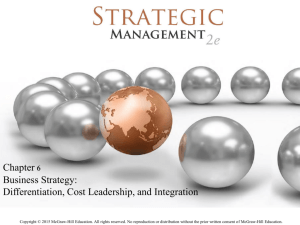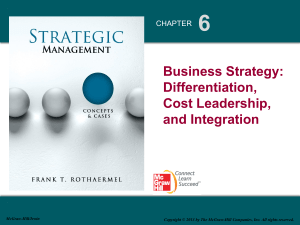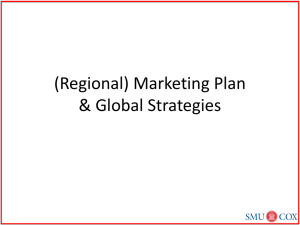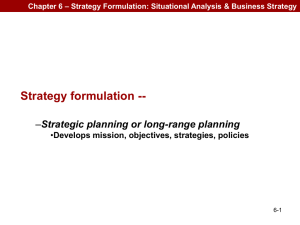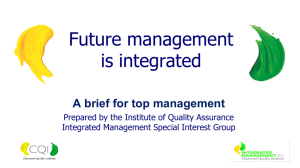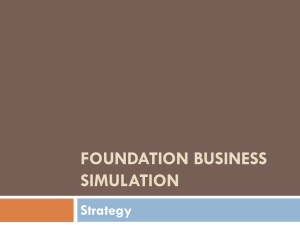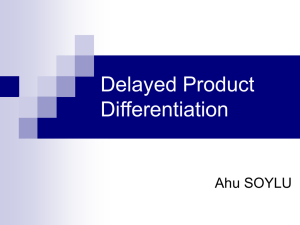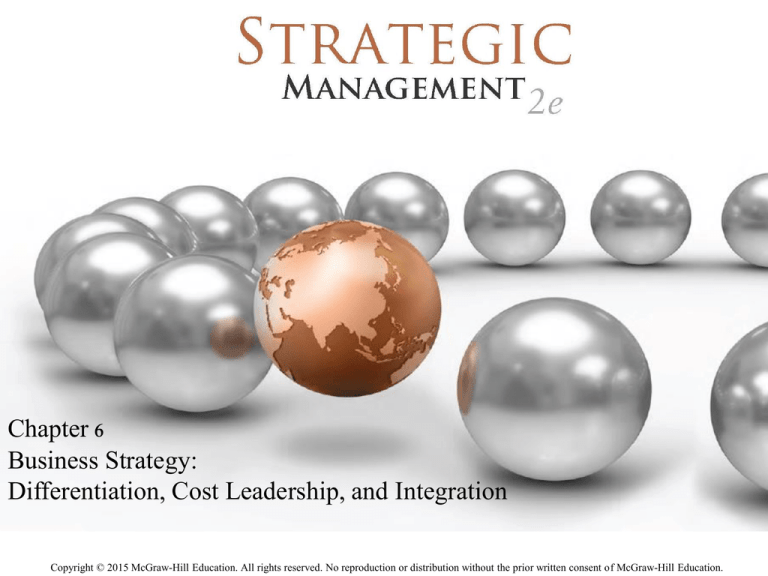
Chapter 6
Business Strategy:
Differentiation, Cost Leadership, and Integration
Copyright © 2015 McGraw-Hill Education. All rights reserved. No reproduction or distribution without the prior written consent of McGraw-Hill Education.
6-2
6.1 Business-Level Strategy: How to
Compete for Advantage
BUSINESS-LEVEL STRATEGY
The goal-directed actions managers take in their quest
for competitive advantage when competing in a single
product market
Who – which customer segments – will we serve?
What customer needs, wishes, and desires will we
satisfy?
Why do we want to satisfy them?
How will we satisfy our customers’ needs?
6-3
HOW TO COMPETE FOR ADVANTAGE
DIFFERENTIATION
• Create higher value by delivering products/services with
unique features
COST LEADERSHIP
• Create similar value by delivering products/services at a
lower cost and lower prices than competitors
INTEGRATION
• Combination of differentiation and cost-leadership strategies
6-4
Exhibit 6.1 Industry and Firm Effects
Jointly Determine Competitive Advantage
6-5
Strategic Position
The greater the economic value created (V – C), the
greater the firm’s competitive advantage.
A firm’s business-level strategy determines its
strategic position.
A business strategy is more likely to lead to a
competitive advantage if it allows firms to either
perform similar activities differently, or perform
different activities than their rivals.
6-6
Generic Business Strategies
Generic strategies (i.e., universal) – independent of
industry – can be used by any organization –
manufacturing or service, large or small, for-profit or
non-profit, public or private, U.S. or non-U.S. – in the
quest for competitive advantage.
Value creation and cost tend to be positively
correlated. Thus, there exist important trade-offs
between value creation and low cost.
6-7
Exhibit 6.2 Strategic Position and
Competitive Scope: Generic Business Strategies
6-8
6.2 Differentiation Strategy:
Understanding Value Drivers
Product Features
• Most important & clearest drivers
• Unique product features >> higher price
BMW M3
Customer Service
• ID unmet customer needs & satisfy them
Zappos online retailer
Ritz-Carlton
Complements
• Add value when consumed as a bundle
AT&T U-verse with a DVR add-on
6-9
Strategy Highlight 6.1
Trimming Fat at Whole Foods Market
Whole Foods had lost its competitive advantage due to a
failure to control costs effectively.
Trim the fat:
• Champion healthy living by offering natural and organic food
choices, while also educating consumers
• Increase private label by 5% to include over 2,300 products
A clearly formulated business strategy enables Whole
Foods to increase the differentiation value gap and
command premium prices, while keeping its cost structure
in check.
6-10
6.3 Cost-Leadership Strategy:
Understanding Cost Drivers
A Cost-Leadership
Strategy With
Adequate Value
• Managers can
manipulate cost
drivers to keep their
costs low.
Cost Drivers
• Cost of input factors
• Economies of scale
• Learning-curve
effects
• Experience-curve
effects
6-11
Strategy Highlight 6.2
Ryanair: Lower Cost than the Low-Cost Leader!
Ryanair has unbundled air travel to its extreme.
More than 20% of Ryanair’s revenues flow from
ancillary services: premium-rate phone line to contact
them, checked bags, checking in, pillows, blankets,
water.
Ryanair offers the basic service (air travel only) for a
low price, but charges a steep premium for all other
items and upgrades.
6-12
Exhibit 6.5 Economies of Scale, Minimum
Efficient Scale, and Diseconomies of Scale
6-13
Economies and Diseconomies
of Scale
Economies of Scale – output up, cost per unit down
• Spread fixed costs over large output
Microsoft upfront R&D for Windows upgrades
• Specialized systems
ERP software or robots
• Physical properties
Cube-square rule for "big box" stores
Minimum Efficient Scale (MES)
• Lowest cost position constant returns to scale
Diseconomies of Scale
• Complexity of management or physical limits
Gore Associates and aircraft aeronautics
6-14
Cost Drivers: Learning & Experience
Curves
Learning Curves
• Steeper curve = more learning
Aircraft manufacturing
Cardiac surgeons
Experience Curves
•
•
•
•
Combine economy of scale & learning curves.
Scale comes down a given learning curve.
Technology allows movement to steeper curve.
Combination can leapfrog in competitive advantage.
Walmart high volumes & technology leadership
6-15
Exhibit 6.6
Gaining Competitive Advantage
Through Leveraging Learning & Experience Curve Effects
6-16
6.4 Business-Level Strategy and the
Five Forces: Benefits and Risks
Cost-Leadership
Benefit: protected
from competitors if
price war
Risk: new entrant
arrives and new
capabilities needed
Differentiation
Benefit: reduced
rivalry & high cost of
imitation
Risk: might overshoot
features needed &
vulnerable to pricesensitive customers
6-17
6.5 Integration Strategy: Combining
Cost Leadership and Differentiation
Firms skilled in both lowering costs and uniqueness
Difficult because the firm manages internal value chain
activities that are fundamentally different from one
another
Integration can work if investments are not substitutes
but rather complements.
• Providing important spill-over effects
The goal of an integration strategy is a larger economic
value (V − C) than that of rivals.
6-18
Exhibit 6.8 Integration Strategy vs.
“Stuck in the Middle”
6-19
Exhibit 6.9
Target’s Attempt at Achieving
Competitive Advantage by Pursuing an Integration Strategy
6-20
Value and Cost Drivers of
Integration Strategy
Quality
Can increase perceived value & lower cost (V − C)
Economies of Scope
Starbucks adding hot tea to its menu
Customization
BMW, Threadless.com, Toyota all mass customization
Innovation
IKEA - stylist furniture in flat pack delivery
Structure, Culture, & Routines
Ambidextrous organization – Intel
6-21
Exhibit 6.10 Value and Cost Drivers
6-22
6.6 The Dynamics of Competitive
Positioning
Strategic Positions Need to Change over Time
• PC assemblers need to move to tablets or smartphones
Productivity Frontier
• Value-cost relationship
• Captures the best practices at a point in time
PC Industry
2010 – Apple was a differentiator; HP & Lenovo were “stuck in
middle.”
2013 – Lenovo was a differentiator in laptops and desktops, HP still
has problems with software transformation, Apple seems to be
moving into lower-end products and toward an integration strategy.
6-23
Exhibit 6.11 The Dynamics of
Competitive Positioning in the PC
Industry: Apple, Lenovo, HP, & Dell
6-24
6.7 Implications for the Strategist
Well-formulated and implemented strategies =
Enhanced chances of superior performance
Integration strategies successful only if:
• An innovation that reconciles the trade-offs, such as Toyota
lean-manufacturing approach in ‘80s & ‘90s
Goal is to stay on the productivity frontier.
6-25
ChapterCase 6
©Diego Giudice/Corbis
Consider This…
• P&G generally charges a 20–40% premium for its
products, reflecting higher value creation, consistent
with its differentiation strategy.
• Recently, P&G lost market share because of its higher
prices, and its profit margins have also been squeezed by
the rising costs of input factors.
• P&G has slashed its R&D spending in recent years by as
much as 50% in an attempt to bring in more innovation
from the outside through its Connect+Develop initiative.
6-26
Take-Away Concepts
LO 6-1
Define
business-level
strategy and
describe how it
determines a
firm’s strategic
position.
Business-level strategy determines a firm’s strategic
position in its quest for competitive advantage when
competing in a single industry or product market.
Strategic positioning requires that managers address
strategic trade-offs that arise between value and
cost, because higher value tends to go along with
higher cost.
Differentiation and cost leadership are distinct
strategic positions.
Besides selecting an appropriate strategic position,
managers must also define the scope of competition −
whether to pursue a specific market niche or go after the
broader market.
6-27
Take-Away Concepts
LO 6-2
Examine the
relationship
between value
drivers and
differentiation
strategy.
The goal of a differentiation strategy is to increase
the perceived value of goods and services so that
customers will pay a higher price for additional
features.
In a differentiation strategy, the focus of competition
is on value-enhancing attributes and features, while
controlling costs.
Some of the unique value drivers managers can
manipulate are product features, customer service,
customization, and complements.
Value drivers contribute to competitive advantage
only if their increase in value creation (ΔV) exceeds
the increase in costs (ΔC).
6-28
Take-Away Concepts
LO 6-3
Examine the
relationship
between cost
drivers and
the costleadership
strategy.
The goal of a cost-leadership strategy is to reduce
the firm’s cost below that of its competitors.
In a cost-leadership strategy, the focus of
competition is achieving the lowest possible cost
position, which allows the firm to offer the lowest
price while maintaining acceptable value.
Some of the unique cost drivers that managers can
manipulate are the cost of input factors, economies
of scale, and learning- and experience-curve effects.
No matter how low the price, if there is no
acceptable value proposition, the product or service
will not sell.
6-29
Take-Away Concepts
The five forces model helps managers
LO 6-4
use generic business strategies to
Assess the benefits
protect themselves against the industry
and risks of costforces that drive down profitability.
leadership and
Differentiation and cost-leadership
differentiation
strategies allow firms to carve out
business strategies
strong strategic positions, not only to
vis-à-vis the five
protect themselves against the five
forces that shape
forces, but also to benefit from them in
competition.
their quest for competitive advantage.
Exhibit 6.7 details the benefits and risks
of each business strategy.
6-30
Take-Away Concepts
LO 6-5
Evaluate value
and cost drivers
that may allow a
firm to pursue
an integration
strategy.
To address the trade-offs between
differentiation and cost leadership
at the business level, managers may
leverage quality, economies of
scope, innovation, and the firm’s
structure, culture, and routines.
The trade-offs between
differentiation and low cost can
either be addressed at the business
level or at the corporate level.
6-31
Take-Away Concepts
LO 6-6
Explain why
it is difficult
to succeed at
an integration
strategy.
A successful integration strategy requires
that trade-offs between differentiation
and low cost be reconciled.
Integration strategy often is difficult
because the two distinct strategic
positions require internal value chain
activities that are fundamentally different
from one another.
When firms fail to resolve strategic
trade-offs between differentiation and
cost, they end up being “stuck in the
middle.” They then succeed at neither
strategy, leading to a competitive
disadvantage.
6-32
Take-Away Concepts
LO 6-7
Describe and
evaluate the
dynamics of
competitive
positioning.
The productivity frontier represents a
set of best in-class strategic positions
the firm can take relating to value
creation and low cost at a given point in
time.
Reaching the productivity frontier
enhances the likelihood of obtaining a
competitive advantage.
Not reaching the productivity frontier
implies competitive disadvantage if
other firms are positioned at the
productivity frontier.
Strategic positions need to change over
time as the environment changes.
6-33
6-34

